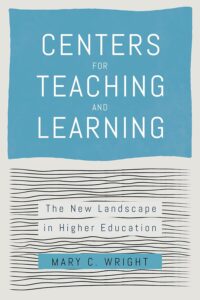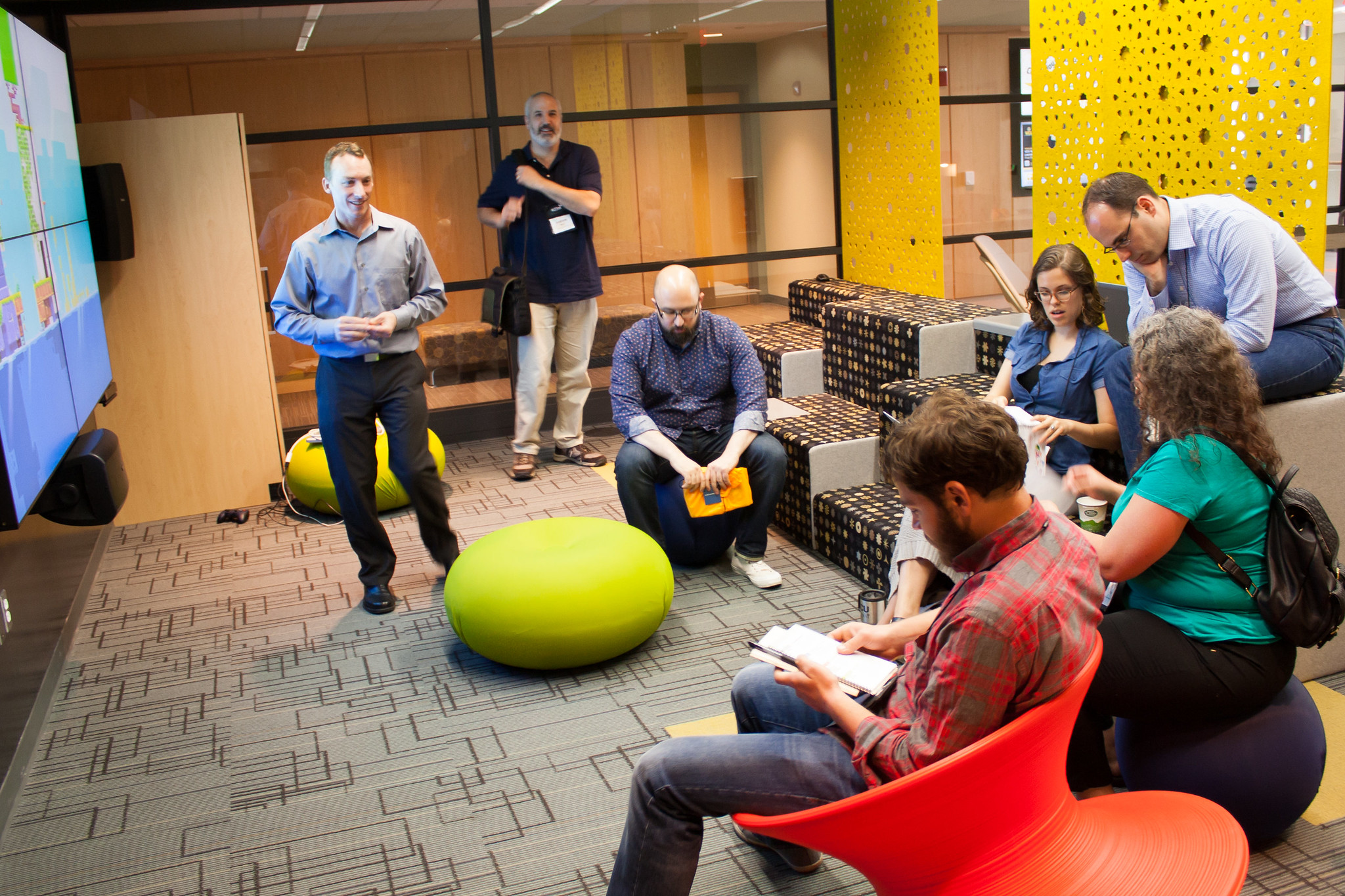Programs, Services, and More: A Map of CTL Tactics
 My colleagues and I at the Center for Excellence in Teaching and Learning (CETL) have been reading and discussing Mary C. Wright’s new book Centers for Teaching and Learning: The New Landscape in Higher Education (Johns Hopkins University Press, 2023). Wright identified all the centers for teaching and learning (CTLs) in the United States and then did a content analysis of their websites to see what they were all about. For someone like me, who has spent his career working in CTLs, Wright’s work is a fascinating look at my own field and how it represents itself through mission statements, listings of programs and services, and annual reports.
My colleagues and I at the Center for Excellence in Teaching and Learning (CETL) have been reading and discussing Mary C. Wright’s new book Centers for Teaching and Learning: The New Landscape in Higher Education (Johns Hopkins University Press, 2023). Wright identified all the centers for teaching and learning (CTLs) in the United States and then did a content analysis of their websites to see what they were all about. For someone like me, who has spent his career working in CTLs, Wright’s work is a fascinating look at my own field and how it represents itself through mission statements, listings of programs and services, and annual reports.
There’s a lot I could say about the book, but I’m going to focus on in this post on Chapter 3: What Tactics Do We Employ? That’s because I missed last week’s CETL book discussion on the third chapter, and I can’t bear not getting credit for doing the homework!
For some context, the first chapter looks at the mission statements posted by CTLs, which Wright uses to distill nine key CTL aims. The three most common aims were student learning, instructor professional learning, and change or innovation. Wright’s second chapter considers the theories of change expressed by CTL mission statements through the lens of a particular metaphorical framework. That would be the HITS framework, in which CTLs act as hubs, incubators, temples, and/or sieves. I was in attendance during Mary Wright’s 2017 POD Network conference presidential address where she shared that framework, and it remains one of the most memorable and useful presidential address I’ve heard at POD. I am very glad to have that framework outlined and applied in Wright’s book.
That brings us to Chapter 3, in which Wright moves from analyzing mission statements to entire CTL websites, cataloging the programs and services that teaching centers use to pursue their aims. Wright frames the chapter with a quote from a 2020 piece by Steven Mintz in which he claims that CTLs’ approach “tends to be pretty uniform, consisting largely of teaching consultations, workshops and classroom observations.” I could have told Mintz back then that not all CTLs are quite so uniform, but I would have been primarily drawing on my experience at the Vanderbilt Center for Teaching. At the CFT, yes, we offered teaching consultations, workshops, and classroom observations, but that was just a small portion of our programs and services. I’m glad to have Wright’s research and book, because instead of anecdotal observations from me or Steven Mintz, we now have copious data on the programs and services that CTLs offer.
Some of Wright’s statistics surprised me (and would likely surprise Mintz). For instance, only 14% of CTLs advertised classroom observation and feedback services. I’ve long considered observations a standard teaching center service, but Wright’s data shows this service is relatively rare. Of course, I’ve worked primarily at teaching centers with large staff sizes (we had 14 full-time staff at the CFT at our peak), and having lots of staff seems critical to offering a robust classroom observation service. Taking a peek at Chapter 4: How Are We Organized?, I see that 24% of CTLs have just one staff member. These “centers of one” aren’t likely to offer a lot of individual consultations, with or without classroom observations. Indeed, out of all the CTLs analyzed, just 44% offer consultations as a service.
What about those teaching workshops that Mintz mentioned? Those are popular offerings, with 72% of CTLs offering interactive workshops according to Wright’s analysis. Bless her heart, Mary Wright’s student research assistant, Emmajane Rhodenhiser, coded over 5,000 advertised workshops according to topic, and they found the following as the most frequently offered workshop topics: Digital teaching and learning (36% of centers offered such topics); diversity, equity, and inclusion (33%); assessment and grading (28%); online / hybrid / remote course design (26%); engagement and active learning (24%); and course and curriculum design (23%). If you work at or participate in the services of a CTL, how does your CTL stack up?

One-shot workshops can only do so much, however, and Wright reports that 18% of CTLs reported offering some kind of course transformation initiative, like a multi-day Course Design Institute (CDI). At the Vanderbilt CFT, we launched a CDI in 2017, and we modeled it on the CDI offered by the University of Virginia’s Center for Teaching Excellence, a model that Wright calls “widely distributed” with “documented impact on learning-focused syllabi and confidence to enact teaching practices.” Wright reports other research showing a “high level of consensus around key concepts” addressed in CDIs. I suspect that’s because many of us were drafting off the good work at the UVA CTE.
Another way to support change over time is to get instructors together on a regular basis to talk about teaching. Whether it’s a book club or community of practice or learning community or a “change team” or something else, Wright found that 41% of CTLs offer some kind of community intended to foster dialogue and collaboration. We found the learning community format remarkable flexible at the Vanderbilt CFT, and it’s one we use in a couple of different ways at the University of Mississippi CELT. One of my favorite learning communities at Vanderbilt was one I co-led with Danielle Picard on teaching with digital timelines, which resulted in an excellent teaching guide on the topic. I’m also fond of a learning community on STEM teaching led by my Vanderbilt colleague Cynthia Brame which produced a great resource called “Science Exams Don’t Have to Be Demoralizing: A Practical Guide.”
There’s one type of program that Mary Wright mentions that I was never able to get started at Vanderbilt. They are fairly rare (just 4% of CTLs have such programs), but I keep hearing great things about students-as-partners programs. These programs feature student consultants who partner with faculty to consult on course or assignment design, either in advance of the course offering or while the course is running. These programs require careful matchmaking between student and faculty partners, as well as training and ongoing support for all involved, but they can result in some of the best kinds of win-wins. Faculty partners develop new insight into how their teaching choices affect their students’ experiences, and student partners start to approach their own learning experiences differently. I am very excited to showcase one such students-as-partners initiative on an upcoming episode of my Intentional Teaching podcast.
One tactic not coded by Wright in this chapter is that of department- and school-based faculty development. There’s a brief mention of this kind of work on page 108, with a quote from Jonathan Torres, the director of the Center for Teaching and Learning at Quinnipiac University: “I help deans/chairs with curriculum mapping, faculty with instructional design, and I work with each school to create ‘faculty development days’ specific to their disciplines and fields.” At Vanderbilt we found this kind of work crucial to expanding our reach and impact, and a recent shift in focus at CETL on departments and schools has already started paying dividends. Perhaps Wright will have more to say about this tactic in later chapters when she reports on her analysis of CTL annual reports.
There are many other kinds of programs and services that Wright details in Chapter 3, including certificate programs, institution-wide events, web resources, midsemester feedback services, open classroom programs, orientations, grant programs, teaching awards, and much more. CTLs offer a lot more than “teaching consultations, workshops and classroom observations,” something that became more known to many faculty and administrators during the COVID-19 pandemic, when CTLs played key roles in supporting remote and online instruction. Wright’s book makes it clear that this more expansive view of CTLs is accurate independent of that time of pandemic teaching. And she makes clear the creativity that CTLs bring to their work as they develop and adapt a variety of tactics toward their individual missions.